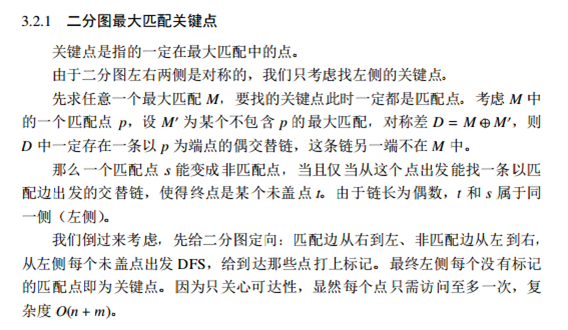bzoj3546[ONTAK2010]Life of the Party
题意是裸的二分图关键点(必然在二分图最大匹配中出现的点).比较经典的做法在cyb15年的论文里有:

前几天写jzoj5007的时候脑补了一种基于最小割可行边的做法:考虑用最大流求解二分图匹配.如果某个点必须在最大匹配中出现,相当于删去这个点后最大匹配数目减少,即删去这个点和源/汇点的连边后剩下的网络中s到t的最小割减小.反之,如果删去这个点后最大匹配数目不变,那么删去这个点和源/汇的连边后网络的最小割不变.上述两个条件分别等价于是否存在一个原网络的最小割方案包含这个点和源/汇的连边,于是转化成网络流中的最小割可行边问题,可以通过在残量网络上用tarjan求SCC解决,即将残量网络上所有流量不为零的正向边和反向边取出,按照边原先的指向建图,求SCC,如果某条满流边连接的两个点在不同的强联通分量中说明这条边是最小割的可行边.这个做法写起来比较麻烦,不是很优越.
#include<cstdio>
#include<cstring>
#include<algorithm>
using namespace std;
const int maxn=,maxm=;
struct edge{
int to,next,w;
}lst[maxm],lst2[maxm];int len=,first[maxn],_first[maxn],first2[maxn],len2=;
void addedge(int a,int b,int w){
lst[len].to=b;lst[len].next=first[a];lst[len].w=w;first[a]=len++;
lst[len].to=a;lst[len].next=first[b];lst[len].w=;first[b]=len++;
}
void addedge2(int a,int b){
lst2[len2].to=b;lst2[len2].next=first2[a];first2[a]=len2++;
// lst2[len2].to=a;lst2[len2].next=first2[b];lst2[len2].w=w;first2[b]=len2++;
}
int n1,n2,m;
int q[maxn],vis[maxn],dis[maxn],s,t,head,tail,T;
bool bfs(){
head=tail=;vis[s]=++T;dis[s]=;q[tail++]=s;
while(head!=tail){
int x=q[head++];
for(int pt=first[x];pt!=-;pt=lst[pt].next){
if(lst[pt].w&&vis[lst[pt].to]!=T){
dis[lst[pt].to]=dis[x]+;vis[lst[pt].to]=T;q[tail++]=lst[pt].to;
}
}
}
if(vis[t]==T)memcpy(_first,first,sizeof(first));
return vis[t]==T;
}
int dfs(int x,int lim){
if(x==t)return lim;
int flow=,a;
for(int pt=_first[x];pt!=-;pt=lst[pt].next){
_first[x]=pt;
if(lst[pt].w&&dis[lst[pt].to]==dis[x]+&&(a=dfs(lst[pt].to,min(lst[pt].w,lim-flow)))){
lst[pt].w-=a;lst[pt^].w+=a;flow+=a;
if(lim==flow)return flow;
}
}
return flow;
}
int dinic(){
int ans=,x;
while(bfs())while(x=dfs(s,0x7f7f7f7f))ans+=x;
return ans;
}
int used[maxn];
int ans1[maxn],ans2[maxn];
int dfn[maxn],clk;
void Dfs(int x,int typ){
dfn[x]=clk;
for(int pt=first[x];pt!=-;pt=lst[pt].next){
if(lst[pt].w==typ&&dfn[lst[pt].to]!=clk)Dfs(lst[pt].to,typ);
}
}
int main(){
memset(first,-,sizeof(first));
scanf("%d%d%d",&n1,&n2,&m);
int a,b;
s=;t=n1+n2+;
for(int i=;i<=n1;++i)addedge(s,i,);
for(int i=;i<=n2;++i)addedge(n1+i,t,);
for(int i=;i<=m;++i){
scanf("%d%d",&a,&b);addedge(a,n1+b,);
}
dinic();
for(int pt=first[s];pt!=-;pt=lst[pt].next){
if(lst[pt].w==)used[lst[pt].to]=;
}
for(int pt=first[t];pt!=-;pt=lst[pt].next){
if(lst[pt].w==)used[lst[pt].to]=;
}
++clk;
for(int i=;i<=n1;++i){
if(!used[i])Dfs(i,);
}
for(int i=;i<=n1;++i){
if(used[i]&&dfn[i]!=clk)ans1[i]=;
}
++clk;
for(int i=;i<=n2;++i){
if(!used[n1+i])Dfs(n1+i,);
}
for(int i=n1+;i<=n1+n2;++i){
if(used[i]&&dfn[i]!=clk)ans2[i]=;
}
for(int i=;i<=n1;++i)if(ans1[i])printf("%d\n",i);
for(int i=;i<=n2;++i)if(ans2[i+n1])printf("%d\n",i);
return ;
}
#include<cstdio>
#include<cstring>
#include<algorithm>
using namespace std;
const int maxn=,maxm=;
struct edge{
int to,next,w;
}lst[maxm],lst2[maxm];int len=,first[maxn],_first[maxn],first2[maxn],len2=;
void addedge(int a,int b,int w){
lst[len].to=b;lst[len].next=first[a];lst[len].w=w;first[a]=len++;
lst[len].to=a;lst[len].next=first[b];lst[len].w=;first[b]=len++;
}
void addedge2(int a,int b){
lst2[len2].to=b;lst2[len2].next=first2[a];first2[a]=len2++;
// lst2[len2].to=a;lst2[len2].next=first2[b];lst2[len2].w=w;first2[b]=len2++;
}
int n1,n2,m;
int q[maxn],vis[maxn],dis[maxn],s,t,head,tail,T;
bool bfs(){
head=tail=;vis[s]=++T;dis[s]=;q[tail++]=s;
while(head!=tail){
int x=q[head++];
for(int pt=first[x];pt!=-;pt=lst[pt].next){
if(lst[pt].w&&vis[lst[pt].to]!=T){
dis[lst[pt].to]=dis[x]+;vis[lst[pt].to]=T;q[tail++]=lst[pt].to;
}
}
}
if(vis[t]==T)memcpy(_first,first,sizeof(first));
return vis[t]==T;
}
int dfs(int x,int lim){
if(x==t)return lim;
int flow=,a;
for(int pt=_first[x];pt!=-;pt=lst[pt].next){
_first[x]=pt;
if(lst[pt].w&&dis[lst[pt].to]==dis[x]+&&(a=dfs(lst[pt].to,min(lst[pt].w,lim-flow)))){
lst[pt].w-=a;lst[pt^].w+=a;flow+=a;
if(lim==flow)return flow;
}
}
return flow;
}
int dinic(){
int ans=,x;
while(bfs())while(x=dfs(s,0x7f7f7f7f))ans+=x;
return ans;
}
int ans1[maxn],ans2[maxn];
namespace Tarjan{
int stack[maxn],top,dfn[maxn],low[maxn],T,belong[maxn],tot;
bool ins[maxn];
void dfs(int x){
low[x]=dfn[x]=++T;ins[x]=true;stack[top++]=x;
for(int pt=first2[x];pt;pt=lst2[pt].next){
if(!dfn[lst2[pt].to]){
dfs(lst2[pt].to);
if(low[lst2[pt].to]<low[x])low[x]=low[lst2[pt].to];
}else if(ins[lst2[pt].to]&&dfn[lst2[pt].to]<low[x])low[x]=dfn[lst2[pt].to];
}
if(dfn[x]==low[x]){
++tot;
do{
ins[stack[--top]]=false;
belong[stack[top]]=tot;
}while(stack[top]!=x);
}
}
void tarjan(){
for(int i=s;i<=t;++i){
if(!dfn[i])dfs(i);
}
}
};
int main(){
memset(first,-,sizeof(first));
scanf("%d%d%d",&n1,&n2,&m);
int a,b;
s=;t=n1+n2+;
for(int i=;i<=n1;++i)addedge(s,i,);
for(int i=;i<=n2;++i)addedge(n1+i,t,);
for(int i=;i<=m;++i){
scanf("%d%d",&a,&b);addedge(a,n1+b,);
}
dinic();
for(int i=s;i<=t;++i){
for(int pt=first[i];pt!=-;pt=lst[pt].next){
if(lst[pt].w){
if(lst[pt^].w)addedge2(i,lst[pt].to);
else addedge2(i,lst[pt].to);
}
}
}
Tarjan::tarjan();
using Tarjan::belong;
for(int i=s;i<=t;++i){
for(int pt=first[i];pt!=-;pt=lst[pt].next){
if(lst[pt].w==&&belong[i]!=belong[lst[pt].to]){
if(i==s&&lst[pt].to<=n1){
ans1[lst[pt].to]=;
}
if(lst[pt].to==t&&i>n1){
ans2[i-n1]=;
}
}
}
}
for(int i=;i<=n1;++i)if(ans1[i])printf("%d\n",i);
for(int i=;i<=n2;++i)if(ans2[i])printf("%d\n",i);
return ;
}
bzoj3546[ONTAK2010]Life of the Party的更多相关文章
- 【BZOJ】【3550】【ONTAK2010】Vacation
网络流/费用流 Orz太神犇了这题…… 我一开始想成跟Intervals那题一样了……每个数a[i]相当于覆盖了(a[i]-n,a[i]+n)这个区间……但是这样是错的!!随便就找出反例了……我居然还 ...
- BZOJ3550: [ONTAK2010]Vacation
3550: [ONTAK2010]Vacation Time Limit: 10 Sec Memory Limit: 96 MBSubmit: 91 Solved: 71[Submit][Stat ...
- bzoj 3545&&3551: [ONTAK2010]Peaks &&加强版 平衡树&&并查集合并树&&主席树
3545: [ONTAK2010]Peaks Time Limit: 10 Sec Memory Limit: 128 MBSubmit: 635 Solved: 177[Submit][Stat ...
- BZOJ 3544: [ONTAK2010]Creative Accounting( BST )
题意 : 一段序列 , 求一段子序列和取余 M 的最大值 其实是一道水题... 前缀和 , 然后就是找 ( sum( r ) - sum( l ) ) % M 的最大值 . 考虑一个 sum( r ) ...
- BZOJ 3545: [ONTAK2010]Peaks( BST + 启发式合并 + 并查集 )
这道题很好想, 离线, 按询问的x排序从小到大, 然后用并查集维护连通性, 用平衡树维护连通块的山的权值, 合并就用启发式合并.时间复杂度的话, 排序是O(mlogm + qlogq), 启发式合并是 ...
- BZOJ 3551: [ONTAK2010]Peaks加强版 [Kruskal重构树 dfs序 主席树]
3551: [ONTAK2010]Peaks加强版 题意:带权图,多组询问与一个点通过边权\(\le lim\)的边连通的点中点权k大值,强制在线 PoPoQQQ大爷题解传送门 说一下感受: 容易发现 ...
- BZOJ 3545: [ONTAK2010]Peaks [Splay启发式合并]
3545: [ONTAK2010]Peaks 题意:带权图,多组询问与一个点通过边权\(\le x\)的边连通的点中点权k大值 又读错题了,输出点一直WA,问的是点权啊 本题加强版强制在线了,那这道题 ...
- bzoj3545: [ONTAK2010]Peaks 重构树 主席树
题目链接 bzoj3545: [ONTAK2010]Peaks 题解 套路重构树上主席树 代码 #include<cstdio> #include<algorithm> #de ...
- 【BZOJ3545】 [ONTAK2010]Peaks
BZOJ3545 [ONTAK2010]Peaks Solution 既然会加强版,直接把强制在线的操作去掉就好了. 代码实现 #include<stdio.h> #include< ...
随机推荐
- codechef Table Game(博弈)
题意 题目链接 很难概括.. Sol (因为比赛还没结束,所以下面讲的可能是“非官方”“正解”) maya这题我前前后后 断断续续的做了一个星期才A掉.CC一场challenge出两道打表题可有点过分 ...
- POJ青蛙的约会
青蛙的约会 Time Limit: 1000MS Memory Limit: 10000K Total Submissions: 114412 Accepted: 23446 Descript ...
- GoF设计模式
GOF23种设计模式简介 GoF(“四人帮”,指Gamma, Helm, Johnson & Vlissides, Addison-Wesley四人)提出的23种设计模式可谓经典,由于其定义比 ...
- uvaoj1225Digit Counting(暴力)
Trung is bored with his mathematics homeworks. He takes a piece of chalk and starts writing a sequen ...
- uiautomatorviewer定位App元素
这个工具是Android SDK自带的, 日常的工作中经常要使用的, 在C:\Android\sdk\tools\bin目录下: 双击之, 请注意, 我一般选择第一个机器人小图标Device Scre ...
- Linux命令应用大词典-第30章 审计系统
30.1 auditctl:控制内核的审计系统 30.2 aureport:生成审计信息报表 30.3 ausearch:搜索审计记录 30.4 autrace:跟踪指定进程 30.5 audit-v ...
- Python简要标准库(1)
sys sys这个模块让你能够访问与Python解释器联系紧密的变量和函数 其中的一些在下表 F argv 命令行参数,包括脚本名称 exit([arg]) 退出当前的程序,可选参数为给定的返回值或者 ...
- Unity OBB分包(基础APK+OBB) 与apk签名
1.OBB (Opaque Binary Blob)文件格式,是安卓游戏通用数据包.在一些大型游戏上较为常见,同时还附以Data文件,亦或是md5.dat文件出现 产生原因:由于某些平台对于apk上传 ...
- 一句话描述 Java 设计模式
Java 设计模式 设计模式是对应于不同的应用目的的. 适配:将特定功能接口适配需求方 桥接:面向两个接口,无关接口的实现: 抽象化与实现化解耦,使得二者可以独立变化:例:笔与图形,笔可以画图 ...
- 打印队列 (Printer Queue,ACM/ICPC NWERC 2006,UVA12100)
题目描述: 题目思路: 使用一个队列记录数字,一个优先队列记录优先级,如果相等即可打印: #include <iostream> #include <queue> using ...
